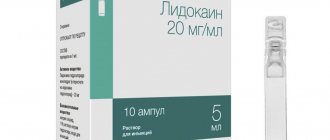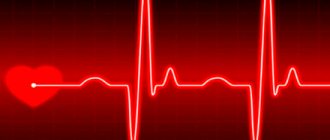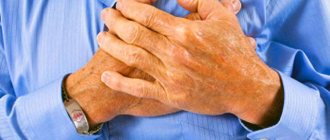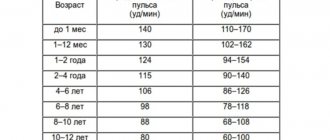Are bradycardia in children and sports compatible? Which section is not suitable for a child with this disease? And, on the contrary, what kind of sport will be useful for him? You will learn about this from our article.
Bradycardia is a disease in which the heart rate decreases. In order to understand what heart rate indicators are considered low, we will learn about the norms.
Children of different ages have their own heart rate (HR):
- Newborns: 140-160 beats per minute;
- Up to a year: 120-140 beats per minute;
- Up to 5 years: the average heart rate reaches 100 beats per minute;
- At 8 years: 90-100 beats per minute;
- At 10 years old: 80-85 beats per minute;
- At 12 years and older: 70-75 beats per minute.
If we take into account the listed values, then a decrease in heart rate of 120 beats per minute or less in infants will be considered bradycardia. For preschool children this is below 70, and for schoolchildren it is 62 or less.
Symptoms of bradycardia
- Semi-fainting, attacks of loss of consciousness or dizziness during a decrease in pulse.
- Arterial hypertension, unstable blood pressure.
- Increased fatigue even after minor physical activity.
- Chronic circulatory failure.
- Angina pectoris of exertion and rest in combination with a decrease in heart rate.
- Weakness.
- Cold sweat.
- Pain in the heart area.
- Shortness of breath (uncharacteristic symptom).
Severe bradycardia
(less than 40 beats per minute) is a very dangerous condition that can cause the development of heart failure, and therefore the patient may require surgery to implant a pacemaker.
Factors in the development of bradycardia
- Sclerotic changes in the myocardium - the muscular layer of the heart, affecting the sinus node.
- Increased tone of the parasympathetic nervous system.
- Increased intracranial pressure (with cerebral edema, tumor, meningitis, cerebral hemorrhage).
- The effect of certain medications for the treatment of cardiovascular diseases (beta blockers, antiarrhythmics, etc.).
- Toxic poisoning with lead, nicotine.
- Hypothyroidism is a decrease in thyroid function.
- Starvation.
- Age-related changes in the heart.
- Diseases of the cardiovascular system (atherosclerosis of the coronary vessels, ischemic heart disease, cardiosclerosis, heart attack, endocarditis, myocarditis, post-infarction scars, etc.).
- Disorders of the metabolism of minerals and electrolytes involved in conducting electrical impulses in the heart.
- Obstructive apnea (stopping breathing during sleep).
- Infectious and inflammatory diseases (rheumatism, systemic lupus erythematosus).
- Hemochromatosis (accumulation of iron in organs and tissues).
- Some diseases not related to the functioning of the cardiovascular system (typhoid fever, jaundice, etc.).
Reasons for the development of deviations
Any person knows from childhood: sport is good, and physical activity contributes to good health and well-being. Constant training leads to changes in blood circulation and energy metabolism, and even positive trends are observed in the nervous system.
The heart adapts to increased loads and its size increases. Myocardial hypertrophy (enlargement of the chambers) is observed, but if you reduce the load, the size of the heart will also decrease. The most noticeable changes appear in athletes who run, ski or cycle. As a result of intense training, changes occur in the sinoatrial node, so the muscle contracts at a reduced frequency.
Smaller changes are noticeable in people who enjoy lifting weights and wrestling, or play hockey or football. For other athletes, the heart beats at its usual rhythm, or the decrease in heart rate at rest is insignificant.
Types of bradycardia
- Absolute bradycardia
- a decrease in heart rate (heart rate) is constant and does not depend on the conditions in which the patient is located. - Relative bradycardia
is a decrease in heart rate under certain conditions (after physical activity, against the background of diseases - fever, traumatic brain injury, typhus, meningitis), a lag between the increase in heart rate and the increase in body temperature. This group also includes “athletes’ bradycardia” – a decrease in heart rate in well-trained people when they perform certain physical exercises. - Moderate bradycardia
- most often observed in children suffering from respiratory arrhythmia during deep inspiration, during sleep, or in the cold. Bradysphygmia, a rare pulse with a normal heart rate, should be distinguished from bradycardia. - Extracardiac vagal bradycardia
– observed in patients suffering from neurological diseases, diseases of internal organs, kidney diseases (nephritis), myxedema and other diseases. - Depending on the reasons that caused bradycardia, physiological and pathological bradycardia are distinguished. Pathological bradycardia is represented by two main forms - sinus bradycardia and bradycardia due to heart block.
Diagnosis of bradycardia in athletes
To identify cardiac bradycardia during sports, it is necessary to undergo a comprehensive medical examination; it is not possible to independently identify the disease during physical activity.
To determine the degree and severity of bradycardia during physical activity, it is necessary to undergo the following studies:
- Electrocardiography.
- Echocardiography.
- Comprehensive clinical assessment.
- Stress Testing.
Typically, athletes only need to undergo an ECG. Other research methods are necessary if there are symptoms of pathological bradycardia in order to exclude other diseases.
Complications of bradycardia
Rarely bradycardia
can also occur in healthy people.
A moderate degree of bradycardia
is not dangerous and does not cause serious disturbances in the functioning of the cardiovascular system.
However, if attacks of bradycardia
are repeated, this can lead to a lack of blood supply and oxygen starvation of organs and tissues, as a result of which their full functioning is disrupted. Acute oxygen deficiency can cause Morgagni–Adams–Stokes syndrome, in which a sudden loss of consciousness occurs.
A more serious complication of bradycardia
is the depletion of the myocardium - the heart muscle, which occurs as a result of fibrillation of the ventricles of the heart. Over time, rupture of the heart muscle (myocardial infarction) and death are possible.
Treatment of bradycardia
Treatment of bradycardia
at GUTA CLINIC it begins with a correct diagnosis - after all, the successful outcome of treatment depends on establishing the exact cause of the disease.
If, against the background of a decrease in heart rate, no diseases that could cause bradycardia
are diagnosed, and there are no symptoms of the disease, then
bradycardia
is not treated
- If a slow heart rate is caused by a medical condition, such as hypothyroidism or electrolyte imbalance, correcting the problem is usually enough to stabilize your heart rate.
- If bradycardia
is a consequence of taking any medications, the attending physician will recommend reducing the dose or prescribing an analogue of the drug being taken that does not cause changes in heart rate. If for some reason it is not possible to take these measures, the patient may be recommended to have a pacemaker implanted.
Regardless of the cause of the disease, treatment of bradycardia
is to bring the heart rate to a level at which the blood supply to the body is sufficient.
Untreated bradycardia
or its incorrect treatment can lead to quite serious consequences - from fainting and general deterioration in health to paroxysms and death.
Diagnosis of bradycardia
at GUTA CLINIC it is carried out using the most modern expert-level equipment, and treatment is carried out by highly qualified cardiologists, candidates of medical sciences and doctors of the highest qualification category, who regularly improve their knowledge and exchange experience with foreign colleagues.
Many of our specialists have completed internships and training in the largest specialized medical centers in Europe and the USA, and have a number of scientific publications on the diagnosis and treatment of cardiovascular diseases, incl. and bradycardia
.
Treatment of bradycardia
at GUTA CLINIC it is carried out individually depending on the patient’s age, symptoms, characteristics of the course of the disease, the form of bradycardia and other individual indicators.
The cardiologists at GUTA CLINIC have hundreds of successfully treated patients with various forms of bradycardia
, including complicated ones.
In everyday practice, a doctor often has to deal with the phenomenon of bradycardia in children. Bradycardia is a rare heartbeat or a slow heart rate below normal for age.
The criteria for bradycardia in children of different age groups have significant differences. So, for example, for an 8-year-old child, bradycardia is considered to be a decrease in heart rate (HR) of less than 66–74 beats per minute, and for a 2-month-old child, a heart rate of less than 119–144 will be considered bradycardia. In an adult (over 18 years of age), bradycardia is a decrease in heart rate below 59 beats per minute. The older the child, the slower the frequency of his rhythm becomes. A baby is born with a heart rate of 140–160 beats per minute, and by the age of 8–11 years, its rhythm slows down to 75–95 beats per minute. This is due to the fact that as the child grows, the volume of blood circulating in the body increases, the size of the heart increases, the ability of the heart muscles to contract decreases, the vessels become less elastic, and the length of the vessels in the body increases; the susceptibility of the cardiovascular system to vasoactive substances circulating in the blood changes. For example, a newborn baby’s heart weighs only 15–25 g; it can push only 3–4 ml of blood. The heart of a healthy adult weighs about 200–250 g. Such a heart can push out from 70 to 90 ml of blood with one contraction. Therefore, normally, the heart rate in children will be higher than in adults, and will depend on age, height, weight, physical activity, sleep or wakefulness. Accordingly, with a physiologically high heart rate in a child, bradycardia values will be in a certain range for each age group.
The prevalence of bradycardia in practically healthy children without obvious heart pathology is quite high. Most often, changes are detected by chance during preventive examinations, clinical examinations, and during examinations after illnesses (mainly of an infectious nature). At the same time, children with bradycardia most often do not make complaints about poor health, tolerate physical activity well, and lead a normal lifestyle. But, unfortunately, bradycardia may not always be asymptomatic and harmless.
The reasons for bradycardia in children can be different. More often, bradycardia in a healthy child is a normal reaction of the body to accelerated growth and rapid/or slow weight gain (this is especially typical for young children - up to 3 years old, as well as during adolescence). If a child regularly attends a sports section, and physical activity is common for him, then such a small athlete will most likely have bradycardia. Also, a slowing of the heart rate without clinical manifestations occurs in children with underweight, with retarded physical development, in children who are often ill, after suffering from colds and infectious diseases, in premature infants.
What happens in the body during bradycardia?
When heart rate decreases, the speed of blood movement through the vessels also slows down. This leads to a decrease in the supply of oxygen and the removal of carbon dioxide in organs and tissues of all systems. The organs most vulnerable to hypoxia are affected first: the brain and heart. Therefore, with bradycardia, a child may experience dizziness, headaches, weakness, increased fatigue (cannot tolerate even moderate physical activity), the child wants to sleep all the time, concentration decreases, appetite decreases, and fainting may occur. If your child faints, you should consult a doctor immediately. For the most part, such loss of consciousness is not dangerous, but there are a number of clinical conditions that still require immediate treatment.
Therefore, a child with bradycardia should be monitored by a cardiologist, undergo timely preventive examinations and, if necessary, receive treatment. The doctor determines the risks and dangers of bradycardia for each small patient individually, based on complaints, life history, physical fitness, clinical manifestations, finding out whether the child is taking any medications that slow down the heartbeat, and whether there are any concomitant diseases that can lead to bradycardia ( kidney disease, heart disease, thyroid gland, pancreas disease, obesity, diabetes, neurosis...). And one of the most important points is assessing the dynamics of heart rate using the ECG (what bradycardia is - moderate/severe, regular/irregular, is it stable). There may be other more serious rhythm disturbances, accompanied by a rare pulse - atrioventricular block of the 2nd and 3rd degree, sinoatrial block of the 2nd and 3rd degree, sick sinus syndrome. In such conditions, it may be necessary to install an artificial pacemaker (pacemaker). Having received all the information about the child’s condition, the doctor, if necessary, will prescribe an additional examination (usually an ECG for rhythm, an ECG with stress (physical, drug), Holter ECG monitoring, echocardiography, blood tests - CBC, determination of blood viscosity, electrolyte composition , study of hormonal status, etc.).
Parents of children observed with bradycardia should properly organize the optimal motor mode for the child (on the recommendation of a cardiologist), monitor the fullness of sleep, and avoid overwork. It is important to maintain normal body weight and eat right. Avoid salty, smoked, spicy and fatty foods, as well as fizzy drinks. Increase the amount of foods containing elements and vitamins “necessary” for the heart - bananas, oranges, persimmons, lettuce, spinach, pumpkin, potatoes, dried apricots, dairy products, fish, porridge (millet, rolled oats, buckwheat).
Results: Most often, bradycardia in children is temporary and as they grow older, it can disappear without a trace. In children, this condition is quite easy to correct if necessary. But the decision about what to do with bradycardia and whether it needs to be treated is made only by a cardiologist.











